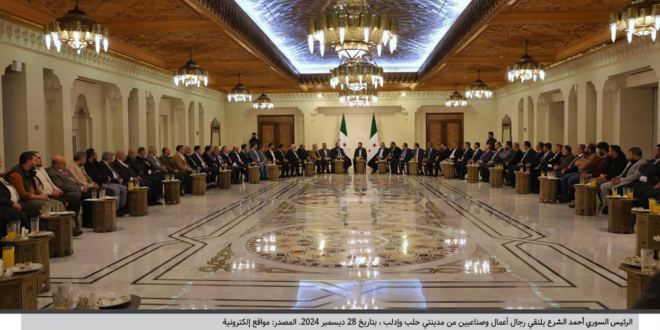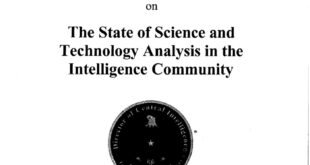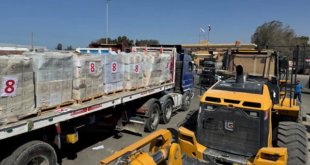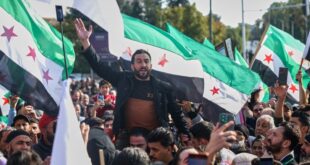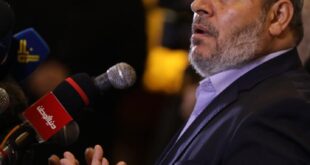The economic sanctions imposed on Syria since 2011 constitute one of the most significant obstacles to any economic recovery efforts, as they have contributed to deepening the humanitarian crisis and hampering reconstruction. These sanctions are primarily imposed by the United States and the European Union and target vital sectors such as oil and gas, banking, and foreign investment.
Syria witnessed a radical transformation with the regime change on December 8, 2024, after Syrian opposition forces took control of Damascus. Despite the sense of relief among some Syrians, the future remains uncertain in light of extremely complex economic challenges, the roots of which go back to the crisis that erupted in 2011. This crisis was the result of a combination of several factors: a severe drought that lasted from 2006 to 2011, worsening economic conditions, and the so-called “Arab Spring,” which led to the country’s rapidly deteriorating situation, leaving the economy today facing enormous challenges. The GDP collapsed by 84%, the poverty rate exceeded 90%, and infrastructure deteriorated significantly. In light of this, this paper attempts to clarify the needs of the Syrian people regarding reconstruction and rebuilding, rehabilitating infrastructure, improving basic services, stimulating economic life, and reviving important sectors such as tourism. It also reviews the current reality in Syria from these perspectives to identify the challenges and opportunities available, by answering a set of questions such as: What are the main challenges facing Syria? How can infrastructure and services be improved? What are the prospects for economic life and tourism in Syria? And related sub-questions. It should be noted that it is difficult to obtain accurate figures and data, as statistics and indicators issued by international organizations (humanitarian, economic, or development) are, in most cases, no more than estimates. Finding the correct figure, or perhaps the closest and least inaccurate one, from among a large group of often conflicting estimates, has been the main challenge.
The economic landscape after the outbreak of the Syrian crisis
Before 2011, the Syrian economy was relatively diversified. Its performance wasn’t stellar, but it was growing, according to Benjamin Fife, a researcher at the Triangle Research Center in Lebanon. “The Syrian economy benefited from wheat, phosphate, and fuel exports, a small industrial base, rising real estate prices, and tourism revenues,” he says. However, the Syrian crisis has had massive economic and humanitarian repercussions. The economy deteriorated sharply in the years leading up to the regime change. According to economic and social indicators, by the end of 2024, the percentage of the population living below the poverty line exceeded 90%, while the local currency (the Syrian pound) had lost nearly 99% of its value since the beginning of the crisis in 2011. At least 70% of Syrians now rely on humanitarian aid to meet their basic needs, amid the ever-increasing cost of living and the collapse of purchasing power. In addition to the humanitarian crises, the country has witnessed the largest refugee crisis in modern history, with millions of Syrians internally and externally displaced, and a significant decline in per capita income. More than 90% of Syrians earn less than $2.15 a day, and nearly 13 million Syrians face severe hunger due to the collapse of food systems and skyrocketing prices.
In addition to the repercussions of the crisis, the country faced a series of successive crises that exacerbated the humanitarian and economic situation. In 2019, the Lebanese economic crisis impacted the Syrian economy due to the close economic and financial ties between the two countries. Syria imposed multiple exchange rates for various transactions to ensure access to scarce hard currency. After the official exchange rate was around 435 Syrian pounds to the dollar at the beginning of 2019, it exceeded 3,000 Syrian pounds to the dollar in late 2020 on the parallel market. In 2021, the country was hit by a second drought, exacerbating food and water shortages. In 2022, the war in Ukraine led to a rise in global food and fuel prices, severely impacting Syria, which is highly dependent on imports. The devastating earthquake that struck the country in February 2023 led to the displacement of approximately 600,000 Syrians. In 2024, the war between Israel and Hezbollah led to an influx of more than half a million refugees into Syria.
Overall, the crisis has resulted in massive economic devastation, estimated at $254.7 billion by a 2015 study conducted by the Syrian Center for Policy Research, co-funded by the United Nations Development Programme (UNDP). This figure includes lost GDP due to the abrupt halt to pre-2010 growth patterns, as well as the estimated cost of destruction. By 2020, this estimate had risen to $442 billion, according to a study by the United Nations Economic and Social Commission for Western Asia (ESCWA). This includes approximately $118 billion in physical infrastructure destruction and $324 billion in lost economic revenue. The estimated losses reached unprecedented levels in a UNDP report, “Impact of the Conflict in Syria: A Devastated Economy, Endemic Poverty, and the Difficult Road Ahead to Socio-Economic Recovery,” which estimated the financial and economic cost would reach $923 billion by the end of 2024.
Meanwhile, international support for the humanitarian response in Syria has declined as donors have grown tired of the increasingly complex Syrian crisis, especially as the international community has become preoccupied with other urgent humanitarian crises in Sudan, Gaza, and Ukraine. This has had an impact on funding for the UN humanitarian plan, with the aid fund receiving only 28% of its estimated financial needs by the end of 2024, putting the country’s humanitarian situation on the brink of collapse.
The economic landscape after regime change
More than three months have passed since the regime change. This is too short a period to expect tangible results on the ground, but it is sufficient to grasp the complexities of reality and overcome the feelings that the change has brought. It has brought different economic manifestations and new challenges, as indicated by repeated observations in major Syrian cities. Among them are hundreds of stalls spread along sidewalks and streets, most of which sell goods smuggled from Turkey or that entered the country via Idlib. These are cheap goods of the lowest quality, suitable for the very low income of Syrians, and not for the country’s regular merchants, whose suffering has doubled.
One of the most noticeable features on the streets of Damascus is the large number of money changers (mobile or commercial exchange shops that have added money change to their regular activities) willing to exchange Syrian pounds for any foreign currency, at a rate approximately 40% lower than the official rate approved by the Central Bank. This phenomenon is unprecedented in other countries, where the exchange rate usually collapses following coups, revolutions, and other major shocks that may affect one country or another. The exchange rate issue is also linked to an additional phenomenon: the long lines of people trying to withdraw their salaries or deposits from bank ATMs, both public and private, which have set a daily withdrawal limit of no more than 200,000 Syrian pounds (equivalent to $20), and which can reach 500,000 Syrian pounds in the best-case scenario.
Moreover, there are many modern car dealerships bearing license plates either “Liberated” (Idlib, Aleppo, Azaz) or “Idlib Experience”, which Syrians buy in large numbers due to their low prices, despite their frequent breakdowns and the lack of any mechanism for officially registering them and obtaining proper paperwork. These license plates have become perhaps more widespread than the old, regular Syrian license plates. In addition, sellers of smuggled fuel from Lebanon or northwestern Syria (gas, gasoline, and diesel) have flooded the roads, selling these smuggled goods for less than the official fuel price at regular stations, which are almost completely devoid of any buyers due to the price differences between them. The official price of a liter of gasoline is $1.16, but the stations only accept payment in Syrian pounds and choose the exchange rate they prefer, while on the streets it is sold for one dollar per liter.
These observations are new to the Syrian street and have spread since the regime change. However, in order to accurately and objectively describe the Syrian reality and determine what Syrians truly want economically, it is necessary to deeply examine the country’s economic and service-related reality. This is also the right time to begin asking critical questions and carefully assessing the first steps taken by the transitional administration in Syria before the window for real change begins to close. Given the complexities and challenges posed by the ongoing crisis in Syria, it is understandable that reaching an immediate solution may not be possible. However, it is crucial that the transitional administration implement a clear and effective plan that ensures progress in the medium term. Stabilizing the economy remains a fundamental step in addressing broader issues and preventing potential public unrest with unforeseen consequences.
Challenges of the Syrian economy after regime change
The Syrian economy faces major challenges; some are long-standing, some arose as a result of the crisis that erupted in 2011, and some are only beginning to emerge following regime change. After more than a decade of conflict and destruction, partial solutions will not suffice. Only comprehensive and pragmatic reforms, supported by international engagement, will pave the way forward. Although the Syrian economy has never been in worse shape than it has been since 2011, the roots of the crisis run deeper and more complex than mere sanctions and blockades. Attempting to address them without a thorough analysis of their roots will be ineffective and will not lead to practical solutions. The economic crisis will remain confined to general terms such as “sanctions,” “war,” and “corruption”—despite their undeniable impact—which oversimplifies the situation and ignores deeper complexities. The most important of these challenges include:
First: The absence of economic identity
The Syrian economy has been suffering from a profound structural identity crisis, manifested in the absence of a clear development vision and the oscillation of an economic model between restrictive socialism and distorted liberalism. Since independence in 1941, the economic system has been unable to formulate an integrated model capable of balancing development requirements with the demands of social justice, leading to chronic structural distortions. As a result, the Syrian economy has become a hybrid entity, combining the remnants of a central planning system with a mosaic of quasi-capitalist practices that thrived on corruption and nepotism. This fundamental contradiction has deprived the private sector of its flexibility, limited its growth, and exacerbated its inability to achieve the efficiency of the public sector. It has also failed to build a competitive production base amidst the oscillation between selective openness and self-isolation. This structural crisis has worsened during the years of the crisis, forcing the economy to rely on remittances, humanitarian aid, the informal economy, corruption networks, smuggling, and other activities that do not contribute to the GDP or achieve economic growth.
Today, Syria faces the challenge of redefining the identity of its national economy. Either it builds an integrated development model capable of absorbing global transformations, or it will continue to be subject to dependency and fragility. This requires boldly reengineering the tax system, industrial policy, legislative structure, and governance mechanisms. Economic identity is not a slogan, but rather an integrated system of policies and institutions that defines a country’s position on the global economic map. Today, Syria stands at a crossroads: it must either rediscover its economic identity, or its economic policies will remain procedural and identityless.
Second: Unifying the fragmented Syrian economy
The Syrian economy faces a highly complex challenge: unifying four independent economic zones that emerged during the years of crisis, each with its own financial system, trade policies, and currency. This has created sharp disparities in living standards and prevented a real economic recovery.
On the one hand, areas previously controlled by the Syrian regime used the Syrian pound, while northern areas under Turkish influence used the Turkish lira. Meanwhile, the Kurdish Autonomous Administration and the Syrian Salvation Government impose separate economic systems. This diversity has led to a number of difficulties in commercial transactions and financial transfers.
The problem is exacerbated by the divergent protectionist trade policies between these regions, particularly the restrictions imposed on the flow of goods previously, and the current weakness of economic integration. This is particularly true given the fact that a group of businessmen and warlords who have emerged during the crisis outside the traditional sphere may contribute to obstructing any efforts to unify the economy and transform it from a regional to a national one. Furthermore, the management of natural resources, particularly the oil fields controlled by the Syrian Democratic Forces, remains a fundamental point of contention that threatens any attempt to build a unified economic framework.
Unifying the Syrian economy represents a crucial test for the new government, requiring innovative solutions and strong political will to overcome deep divisions. Without the adoption of comprehensive economic reforms and the achievement of genuine political settlements, sustainable economic recovery will remain an elusive goal, threatening to prolong Syria’s suffering. This requires radical reforms, including unifying the national currency, removing restrictive trade restrictions, and adopting policies that support local production without wasting resources on ineffective subsidies. Efforts must also be made to reconcile the interests of the new and traditional economic elites and reach a fair agreement on the sharing of natural resource revenues. This cannot be achieved without an effective international role, particularly from the United States and other influential countries, to ensure respect for the rights of Syrian Kurds and their integration into the country’s economic and political structure, while preventing armed factions from becoming an obstacle to stability.
Third: Agriculture and the challenge of drought
Agriculture in Syria is a fundamental pillar of the national economy, but it faces significant challenges due to increasing droughts and the worsening effects of climate change. Over the past two decades, the country experienced a catastrophic drought between 2006 and 2010, which caused a 60% collapse in agricultural production, the death of massive numbers of livestock, and the displacement of hundreds of thousands of farmers to cities. Currently, the sector faces complex crises, including the deterioration of irrigation infrastructure, which has been damaged by 50% due to a 1.5°C rise in temperatures and an 18% decrease in rainfall. This has led to a decline in agriculture’s contribution to GDP from 20% to just 8%. The crisis has also been exacerbated by a shortage of agricultural inputs and a 300% increase in production costs, forcing more than half the population to rely on food aid.
In the face of these challenges, there is an urgent need to rehabilitate agricultural infrastructure and adopt modern irrigation technologies, along with developing early warning systems and cultivating drought-resistant crops. These are crucial steps toward restoring food security and ensuring social stability in the post-crisis phase.
Fourth: Western economic sanctions
The economic sanctions imposed on Syria since 2011 constitute one of the most significant obstacles to any economic recovery efforts. These sanctions, coupled with the repercussions of the crisis, have deepened the humanitarian crisis and hampered reconstruction. These sanctions are primarily imposed by the United States and the European Union and target vital sectors such as oil and gas, banking, and foreign investment.
On the one hand, these sanctions have completely isolated the Syrian banking and financial sector from the global financial system, due to the US Caesar Act passed by Congress in 2020, which has made it difficult to transfer funds and import essential goods, including medicines and medical equipment.
On the other hand, sanctions have contributed to the collapse of the oil sector. The ban on Syrian oil exports has reduced revenues by 90% compared to pre-2011 levels, forcing Damascus to rely on oil smuggling via middlemen. This reduces revenues, increases corruption, and exacerbates the negative impact on the industrial and commercial sectors, which already struggled to import raw materials and machinery due to the ban on international transactions.
Although the sanctions are theoretically intended to exert political pressure, their real impact has been on civilians’ living standards and hampered reconstruction. Exiting this impasse requires a multi-layered strategy that includes domestic economic reform, smart regional alliances, and realistic international dialogue. In the absence of this, sanctions will continue to hinder any attempt to revive Syria’s battered economy.
Following the regime change, several regional initiatives emerged aimed at supporting the Syrian economy. Turkey proposed providing electricity via floating power plants, while Qatar offered to cover public sector salaries. Syrian businessmen and regional investors also expressed a willingness to finance reconstruction projects and repair vital infrastructure. Despite the potential importance of these initiatives, their actual feasibility remains contingent on the easing of international sanctions, particularly those from the United States. In January 2025, the Biden administration issued six-month sector exemptions under General License No. 24, while in February 2025, the European Union announced the lifting of sanctions on the energy and transportation sectors, four banks, Syrian Airlines, and reconstruction activities. However, these steps have not achieved tangible progress on the economic front, and US sanctions remain the decisive factor in changing this equation.
This presents a highly complex political dilemma. On the one hand, Syria needs economic stability as a prerequisite for a successful political transition. On the other hand, sanctions remain a vital tool for pressuring for comprehensive political reforms. However, continued strict implementation of sanctions without taking into account the deteriorating reality on the ground carries grave risks, potentially leading to the collapse of the entire transitional process.
Fifth: “Traders versus smuggling”
This challenge is one of the emerging aspects of the post-regime era. Areas previously under the former regime, including major Syrian cities, are undergoing radical economic transformations. Local production institutions, merchants, and traditional industrialists face existential challenges as a result of the import and smuggling liberalization policy adopted by the transitional administration. The liberalization measures came as a surprise, and while they can be justified by the promise of a rapid revival of the ailing economy, they may have had negative repercussions for the local production and commercial base, which are likely to worsen in the short and medium term.
By comparison, local production dominated markets under the previous regime. Even smuggling was strictly controlled and restricted to a small group close to the regime. When available, its prices were far beyond the purchasing power of Syrians. Therefore, once the regime changed, imported and smuggled goods—particularly Turkish ones—flooded the local market, placing local producers at an unequal competitive position. Field data indicates that more than half of medium- and small-scale industrial establishments suffer from a marketing deficit, selling their inventory at huge losses, and some have opted for temporary closure.
The first wave of imported goods—which included previously scarce items such as food, cleaning supplies, and cosmetics—evoked mixed social reactions. While initially welcomed by consumers, their positive impact quickly became apparent amid tight cash flow and shrinking purchasing power. It is estimated that cash flow fell by 35% during the first three months of the new administration’s term.
Structurally, this policy has sparked widespread protests in economic circles, particularly in the capital, Damascus, where traditional industrial elites feel deliberately marginalized in favor of the northern regions. Some personal interviews reveal that the majority of merchants and owners of production facilities support the necessity of economic liberalization, but they stipulate that it be implemented within a gradual plan that allows a sufficient transitional period to restructure the production sector and the laws regulating imports and exports.
This issue is of particular importance in strategic sectors such as the pharmaceutical industry, where local factories face the risk of closure this year if the current policy continues. Economic experts point out that the success of any reconstruction plan depends on the transitional administration’s ability to strike a delicate balance between the requirements of economic openness and the imperatives of protecting the national productive base. This will be a true test of its legitimacy and ability to lead the transitional phase.
Sixth: Currency lock-up (liquidity challenge)
Field data indicates a decline in the prices of most consumer goods as a result of the dollar’s exchange rate declining from approximately 15,000 Syrian pounds to the dollar prior to the regime change to approximately 10,000 Syrian pounds after the transitional administration’s first 100 days. This is with the exception of bread, whose subsidies were lifted and whose price increased nearly tenfold. However, this decline did not translate into an actual improvement in citizens’ purchasing power, given a banking system suffering from severe liquidity constraints and a clear failure to adopt modern electronic payment methods.
Daily practices reveal that obtaining cash has become a daily dilemma that drains citizens’ time. They spend long hours in bank queues to withdraw meager amounts that are barely enough to cover basic needs, let alone meet the demands of social and family occasions such as Ramadan and Eid al-Fitr, which have placed additional pressure on Syrians. The scenes outside banks in Damascus, where hundreds of people queue to withdraw amounts not exceeding $15, are evidence of the depth of the cash crisis. This is especially true after the Central Bank of Syria imposed strict withdrawal limits in December 2024, describing them as temporary measures. However, they continue to this day without any tangible improvement. This highlights Syria’s continued reliance on Moscow to meet its paper currency needs, due to Western sanctions that prevent international printing presses from dealing with the Syrian monetary authorities. In early March 2025, the country received a shipment of new banknotes minted in Russia, the total value of which was not disclosed.
This monetary crisis reflects the depth of the structural challenges facing the transitional administration, such as declining public confidence in local banks, citizens’ reluctance to deposit their savings for fear of difficulty in withdrawing them later, the continued reliance on the Russian state printing press (Goznak) to issue the local currency, the lack of transparency in monetary policy, with the failure to publish accurate data on the size of the money supply in circulation, and the private sector’s suffering from a liquidity shortage, which hinders the fulfillment of financial obligations and the payment of salaries.
The future of paper currency raises numerous questions, particularly regarding the fate of the 2,000-lira note bearing the image of the former president. Furthermore, the lifting of export restrictions, despite its expected positive effects, has increased liquidity pressures on local companies already suffering from a sharp decline in sales. These conditions therefore raise fundamental questions about the ability of the new monetary reforms to achieve the desired financial stability in light of a weakened banking infrastructure and ongoing external restrictions.
In fact, the above are just a few of the economic challenges facing Syria today. These challenges are compounded by a host of interconnected, serious challenges that hinder any recovery efforts and have received significant research and analysis both locally and internationally. These challenges include the collapse of the currency and hyperinflation, the destruction of infrastructure, the erosion of the middle class and the widening class gap, the fuel crisis, the spread of smuggling and the illicit economy, and the displacement and refugee crisis (with 6.7 million internally displaced persons and 5.5 million refugees, depriving the economy of skilled labor and competencies). Finally, there is a lack of confidence in economic policies due to the failure of partial reforms and the absence of a comprehensive vision for recovery.
Therefore, while Syrians today may differ greatly in politics, they are much closer in economics. Everyone needs an economy that provides them with a minimum standard of living, within a just and comprehensive economic system, free from corruption and monopoly, in which the country’s resources are distributed across the country, and in which Syrian energies and labor are invested in sustainable projects that improve the standard of living and establish a free and integrated Syrian economy.
Scenarios for the Syrian economic landscape
Economic priorities overlap and differ with the multiplicity and complexity of the challenges. However, Syria’s economic future, which is intrinsically linked to its political future, remains open to a variety of scenarios in the short, medium, and long terms. These scenarios range from the most optimistic to the most pessimistic, and are determined by a number of influential factors: international sanctions, particularly those of the United States; the full resumption of oil flows; the achievement of a comprehensive political settlement; the volume and quality of international aid; and the success of domestic economic reform programs.
Pessimistic scenario (worst case)
The liquidity crisis and the deterioration of the Syrian pound are likely to persist in the short term, due to the potential failure of monetary reforms and the faltering negotiations to restore oil supplies between Damascus and the Kurdish Autonomous Administration. This will lead to the deterioration of the industrial and agricultural sectors due to fuel and electricity shortages, while humanitarian aid continues to flow at insufficient levels. In the medium term, this will be exacerbated by the worsening economic division between areas of influence, the continued financial isolation of Syria due to US sanctions, and the irreversible deterioration of infrastructure, accompanied by an increase in secondary migration waves. Thus, in the long term, Syria will become an economically failed state, completely dependent on foreign aid, with the continued regional fragmentation of the economy and the loss of an entire generation of skilled workers.
Moderate (realistic) scenario
In the short term, we may witness a limited improvement in liquidity with the arrival of regional financial aid, a partial resumption of oil supplies under political conditions, the initiation of initial monetary and customs reforms, and a slight improvement in funding for international organizations. In the medium term, we may see a partial lifting of US sanctions on specific sectors, the initiation of small and medium-sized reconstruction projects with regional funding, a gradual improvement in the electricity and transportation sectors, and a limited return of displaced persons. In the long term, we are expected to see partial reintegration into the regional economy, slow private sector growth, and a relative improvement in human development indicators, while structural challenges persist.
Optimistic scenario (best case)
In the short term, a comprehensive political agreement could lead to the gradual lifting of sanctions, a rapid return of oil and energy supplies, a large international aid package, and radical monetary and customs reforms. In the medium term, international banks could resume operations in Syria, reconstruction projects could begin, productive sectors could grow rapidly, and refugees and displaced persons could return. In the long term, Syria could become a regional logistics hub, witnessing sustained economic growth, comprehensive infrastructure reform, and full integration into the global economy.
Finally , while the current phase offers a real opportunity for economic recovery, achieving the optimistic scenario requires national consensus between political will, internal forces and components, and favorable regional and international conditions. Syria’s long-term recovery will depend on its reintegration into the global economy through trade agreements, regional partnerships, and diplomatic engagement. The monopolization of power and the failure to meet international expectations for political reform and transparency will prolong the economic crisis, thus complicating the country’s political stability. The transitional government can navigate the spaces left vacant by sanctions, but comprehensive and sustainable long-term development will not be possible without access to foreign capital and technology. Furthermore, the timeframe for achieving economic progress is limited, threatening to plunge the country back into a cycle of violence.
 Eurasia Press & News
Eurasia Press & News
